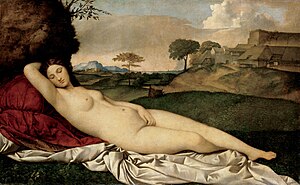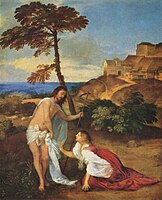Slumbering Venus

|
| Slumbering Venus |
|---|
| Giorgione and Titian , 1510 |
| canvas |
| 108.5 x 175 cm |
| Old Masters Picture Gallery |
The famous picture Slumbering Venus is in the Old Masters Picture Gallery in Dresden. Elector Augustus the Strong acquired it in 1699. It is considered the main work of the Italian Renaissance painter Giorgione and is unprecedented . For the first time a naked Venus was depicted in this image size and thus a model for many later depictions of lying naked women was created.
Image description
“ Slumbering Venus. With her eyes closed, the completely naked goddess of beauty lies stretched out in a blooming landscape. Her head rests on the left under the rock on a pillow covered in red. She has put her right arm under her head, with her left she covers her nakedness. A white linen is spread out below her in the flowery lawn. On the right in the middle distance there is a castell on the hill. In the middle, the gaze wanders over green, undulating land to distant blue mountains that surround a lake. "
The woman
The reclining woman, according to sources Giorgione's lover Cecilia, was depicted by Giorgione with her eyes closed. As a result, she was interpreted as sleeping , although the posture, in particular the arm lying under the head, also allows the interpretation of a resting woman while awake . This interpretation makes sense if one evaluates the creation of images in the context of other historical sources. This is how Dante Alighieri wrote around 1290 in his Vita Nuova , chap. XIX, "Donne ch'avete intelleto d'amore" (The transformation of the beloved into the picture) Verses 43–56:
It says of her Cupid: "A mortal thing,
how can it be so pure and beautiful? "
Then he looks at her and swears to himself
that God intends to create something new in her.
The color of the pearl is almost like that
befitting a lady, not in proportion:
it is how much good nature can do;
by their example one measures beauty.
Out of her eyes when she moves
arise spirits of love - inflamed,
wounded those of the eyes that are only just looking at them,
and penetrate in such a way that everyone reaches the heart:
You see Cupid painted on her face
there where no one can rest.
(Translation: Georg Traska)
The portrayal of his lover with closed eyes could therefore have been an alternative for Giorgione.
The landscape
Giorgione died of the plague in 1510 , according to tradition, his pupil Titian completed the picture. There are various statements in the literature about the scope of Tizian's work
- the white sheet
- the mound on the left
- the fortress wall behind the houses on the right
- as well as parts of a later painted over Cupid , who sat at the feet of Venus
come from Titian. The basic structure of the landscape, the main lines of the hills with their color values, is definitely assigned to Giorgione, here the contours of the reclining figures continue harmoniously in the landscape, here the figure is embedded in the space. How large Titian's share really was cannot be explained with certainty, but the similarity of the group of houses with that of a painting by Titian and Giorgione from the National Gallery in London and mirrored in Titian's painting "Heavenly and Earthly Love" in the Galleria is striking Borghese in Rome.
- Comparable groups of houses
Titian and Giorgione: Noli me tangere ( National Gallery, London )
Detail from the Titian painting: "Heavenly and earthly love" ( Galleria Borghese, Rome )
The center of the picture is a tree stump directly above the left hand of the person lying down, this can be considered a symbol of life and death and has been used by Giorgione several times in other pictures.
The Cupid
The already mentioned Cupid sat at the feet of Venus and was painted over in 1837 because of damage. The damage, as well as damage to the abdomen of Venus, came from palpation.
The assignment of Cupid as a work by Titian was proven with the help of X-rays in 1931. In the illustrated book Giorgione by Terisio Pignatti and Filippo Pedrocco (Hirmer Verlag Munich, 1999) there is a reconstruction of Cupid on page 174: Sitting at the feet of Venus, he takes about 1/3 of the picture height and looks to the right edge of the picture. In his left hand he is holding an arrow pointing downwards, in his right hand he is holding a bird in the air, his winged back is turned towards the beautiful woman. The tip of her right foot partially covers the little boy's seat, so that it also fell victim to the painting over.
Origin and attribution
The sources for the origin of the picture are uncertain; it is referred to either as part of a delivery of 15 pictures in 1699 by the French art dealer C. le Roy or as part of a delivery by the art dealer and painter Kindermann (catalog by Woermann 1887). The difficulties arise from the fact that many depictions of Venus were purchased at the time in question, the exact descriptions of which are inadequate in the files.
The various journeys, rearrangements and classifications of the painting have also affected the attribution of the painting. If in the receipt from C. le Roy of January 26, 1699 a painting was listed as "Un Tableau d'une Venus avec un petit amour del Giorgione, Original", then in the inventory of 1722 the picture was listed under the number A 49 as, For reasons that are no longer comprehensible from today's perspective, "the famous naked Venus, lying on his back" is called by Titian. These erroneous attributions reached their lowest point with the entry in the gallery catalog of 1882 as “Nice copy, probably by Sassoferrato”. These incorrect assignments were only ended with the judgment of the Italian art historian Giovanni Morelli , who in his book: The Works of Italian Masters in the Galleries of Munich, Dresden and Berlin , published in 1880, identified this image as the lost image that an anonymous viewer in the year 1525 had seen in the house of Jeronimo Marcello in Venice: "Venus sleeping with Cupid in an open landscape."
"How such a work, the quintessence of Venetian art, could have remained unnoticed for so long would be a real mystery to me if I didn't know from long experience that the most incredible things in art are possible."
literature
- Daniel Arasse : The woman in the chest . In: Daniel Arasse: Have a look! . Cologne: Dumont 2002. pp. 88-125.
Web links
- Slumbering Venus Staatliche Kunstsammlungen Dresden
- Giorgione: Slumbering Venus Malerei-Meisterwerke.de, accessed on August 25, 2013
- Venetian Masters and the SLUMMING VENUS , accessed August 25, 2013
- Giorgione Slumbering Venus , accessed August 25, 2013
- II. Images , accessed on August 25, 2013
Individual evidence
- ^ A b c Ludwig Justi: Giorgione. - First volume. Reimer, Berlin 1936
- ↑ Richard Muther: History of Painting. - Volume 1. Chryselius, Berlin 1920
- ↑ Rudolf Preimesberger, Hannah Baader and Nicola Suthor (ed.): History of classical genres in source texts and commentaries, Volume 2, portrait. Scientific Book Society, Darmstadt 2003
- ↑ a b c Harald Marx (Ed.) Gemäldegalerie Alte Meister Dresden - Volume 1. The exhibited works. König, Cologne 2005
- ^ Wolfgang Eller: Giorgione. Catalog of works, riddle and solution. Imhof, Petersberg 2007
- ^ A b Hans Posse : The picture gallery in Dresden / The old masters. Baensch, Dresden without a year
- ^ A b c Christoph Schölzel: Gemäldegalerie Dresden, preservation and restoration of works of art from the beginnings of the gallery to 1876. Oettel, Görlitz 2012
- ^ The "Anonymus des Morelli": Notia d'opere di disegno nella prima metà del secolo XVI, essistenti in Padova, Venezia, Milano, Pavia, Bergamo, Crema e Cremona, scritta da un animo die quel tempo, pubblicata e illustrata da D Jacopo Morelli. Bassano 1800



